Abstract
Murine adenovirus type 1 (MAV-1) infection of CB-17 SCID mice (which are homozygous for the severe combined immunodeficiency mutation) induces hepatic histopathologic and ultrastructural features that are strikingly similar to human Reye syndrome. Gross pathologic examination of MAV-1-infected mice revealed only pale yellow liver tissue. Histopathologic studies of tissue from MAV-1-infected mice revealed diffuse hepatic injury manifested by microvesicular fatty degenerative changes of hepatocytes and electron microscopic evidence of focal mitochondrial swelling with disruption of cristae and depletion of glycogen. Serum aminotransferase activities increased markedly in the infected animals; however, plasma ammonia levels were not elevated at the times assayed. Although all mice infected with MAV-1 died, neutralizing anti-MAV-1 monoclonal antibodies provided a dose-dependent delay in the appearance of clinical disease and hepatic histopathologic findings. Other findings included rare viral inclusions with only minimal inflammation in spleen, adrenal, and liver of infected mice. Our findings indicate that MAV-1 infection of SCID mice may provide important insights into the pathogenesis of the hepatic lesions of Reye syndrome.
Full text
PDF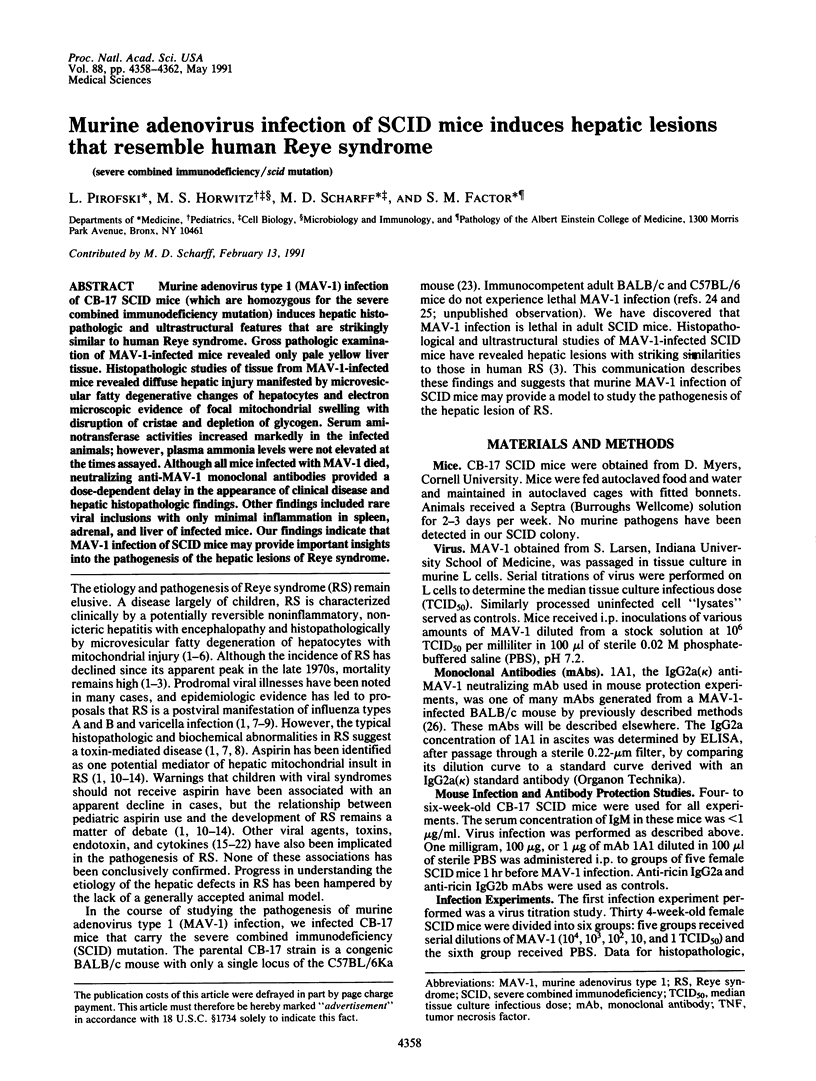
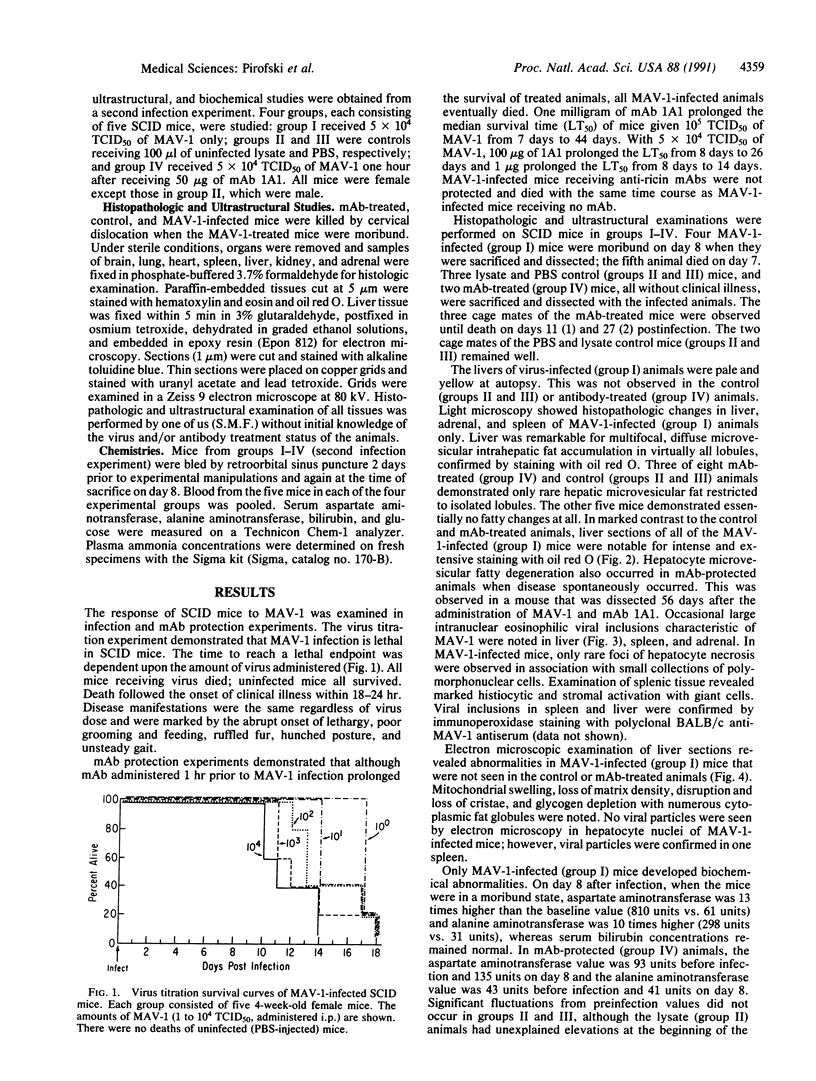
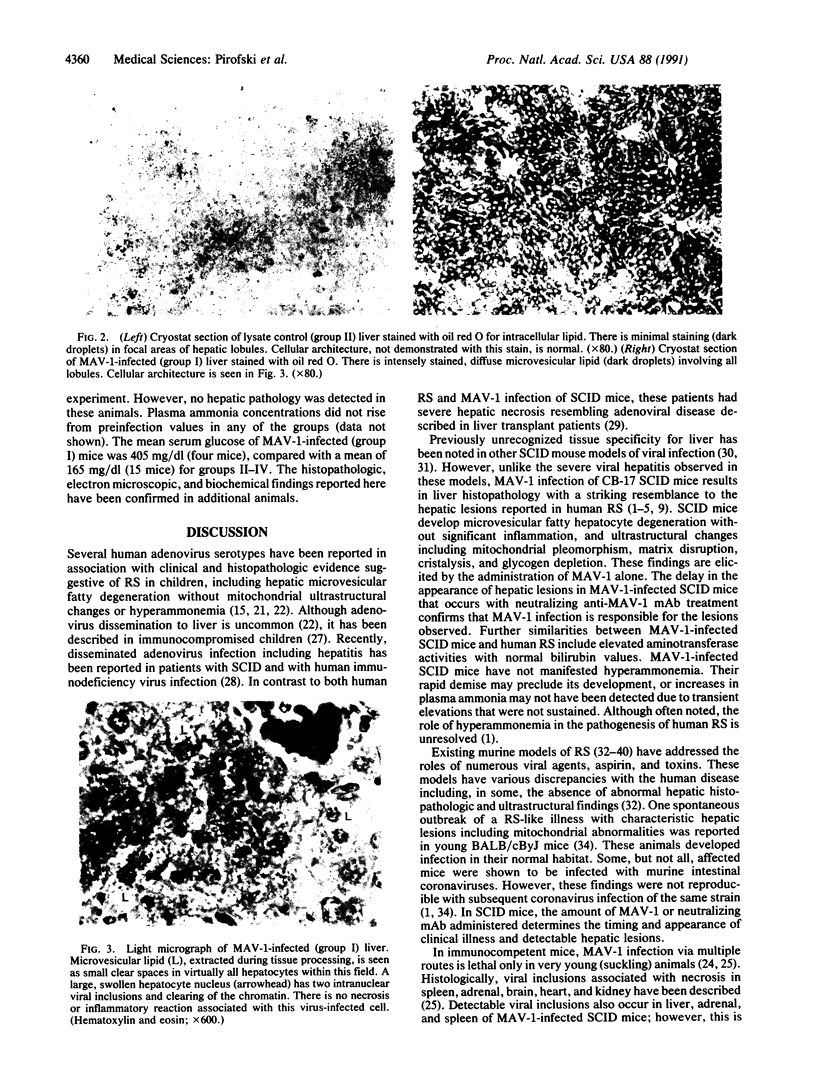
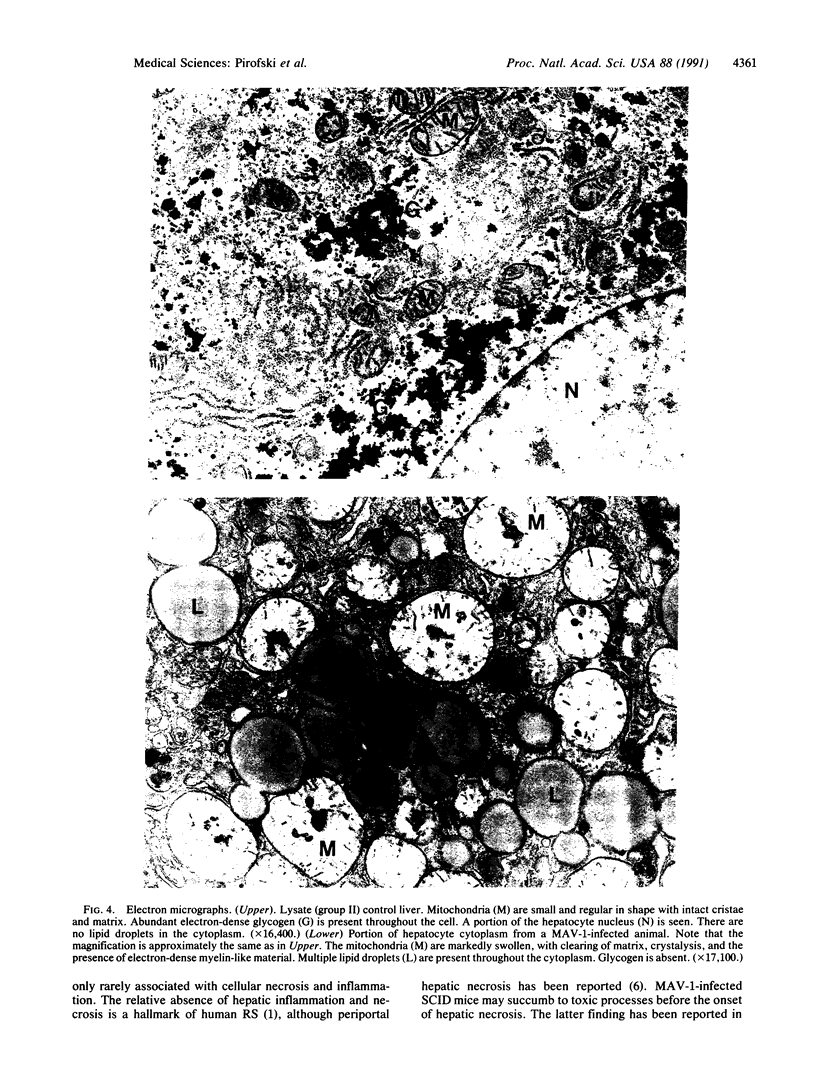
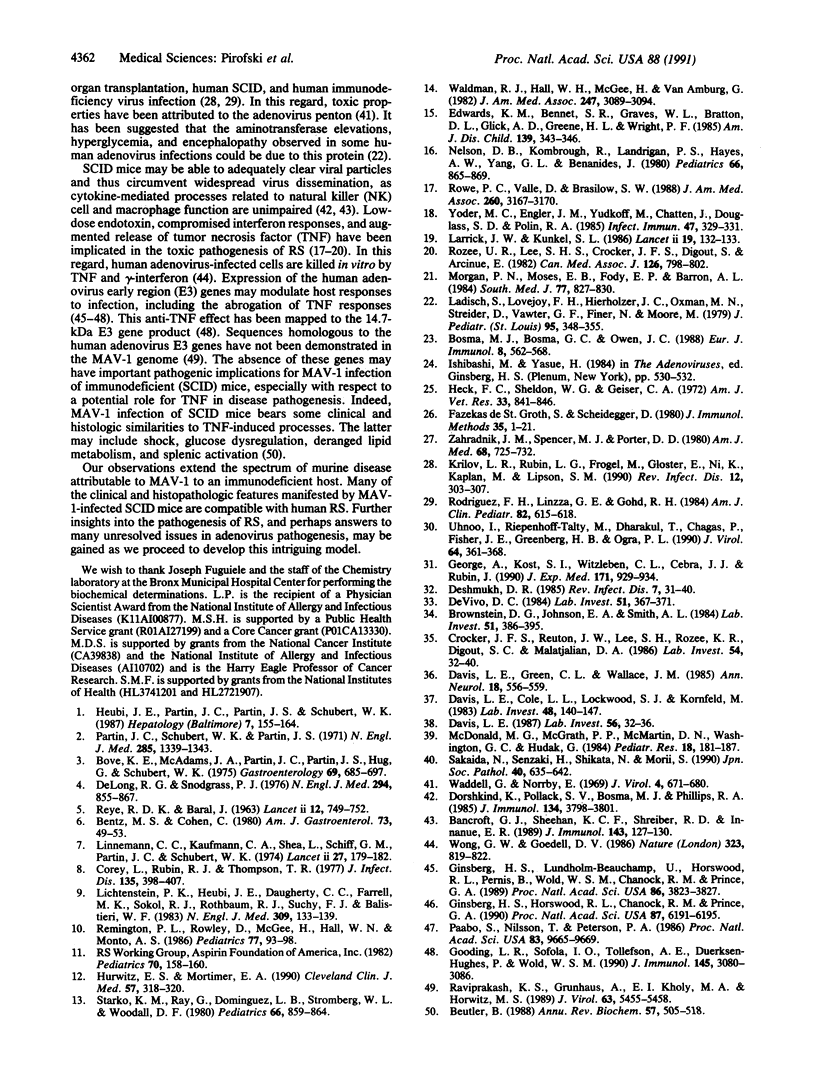
Images in this article
Selected References
These references are in PubMed. This may not be the complete list of references from this article.
- Bancroft G. J., Sheehan K. C., Schreiber R. D., Unanue E. R. Tumor necrosis factor is involved in the T cell-independent pathway of macrophage activation in scid mice. J Immunol. 1989 Jul 1;143(1):127–130. [PubMed] [Google Scholar]
- Bentz M. S., Cohen C. Periportal hepatic necrosis in Reye's syndrome. One case in a review of eight patients. Am J Gastroenterol. 1980 Jan;73(1):49–53. [PubMed] [Google Scholar]
- Beutler B., Cerami A. Tumor necrosis, cachexia, shock, and inflammation: a common mediator. Annu Rev Biochem. 1988;57:505–518. doi: 10.1146/annurev.bi.57.070188.002445. [DOI] [PubMed] [Google Scholar]
- Bosma M. J., Bosma G. C., Owen J. L. Prevention of immunoglobulin production by allotype-dependent T cells. Eur J Immunol. 1978 Aug;8(8):562–568. doi: 10.1002/eji.1830080805. [DOI] [PubMed] [Google Scholar]
- Bove K. E., McAdams A. J., Partin J. C., Partin J. S., Hug G., Schubert W. K. The hepatic lesion in Reye's syndrome. Gastroenterology. 1975 Sep;69(3):685–697. [PubMed] [Google Scholar]
- Brownstein D. G., Johnson E. A., Smith A. L. Spontaneous Reye's-like syndrome in BALB/cByJ mice. Lab Invest. 1984 Oct;51(4):386–395. [PubMed] [Google Scholar]
- Corey L., Rubin R. J., Thompson T. R., Noble G. R., Cassidy E., Hattwick M. A., Gregg M. B., Eddins D. Influenza B-associated Reye's syndrome: incidence in Michigan and potential for prevention. J Infect Dis. 1977 Mar;135(3):398–407. doi: 10.1093/infdis/135.3.398. [DOI] [PubMed] [Google Scholar]
- Crocker J. F., Renton K. W., Lee S. H., Rozee K. R., Digout S. C., Malatjalian D. A. Biochemical and morphological characteristics of a mouse model of Reye's syndrome induced by the interaction of influenza B virus and a chemical emulsifier. Lab Invest. 1986 Jan;54(1):32–40. [PubMed] [Google Scholar]
- Davis L. E., Cole L. L., Lockwood S. J., Kornfeld M. Experimental influenza B virus toxicity in mice. A possible model for Reye's syndrome. Lab Invest. 1983 Feb;48(2):140–147. [PubMed] [Google Scholar]
- Davis L. E., Green C. L., Wallace J. M. Influenza B virus model of Reye's syndrome in mice: the effect of aspirin. Ann Neurol. 1985 Nov;18(5):556–559. doi: 10.1002/ana.410180508. [DOI] [PubMed] [Google Scholar]
- Davis L. E. Influenza B virus model of Reye's syndrome. Evidence for a nonpermissive infection of liver and brain. Lab Invest. 1987 Jan;56(1):32–36. [PubMed] [Google Scholar]
- De Vivo D. C. Do animals develop Reye syndrome? Lab Invest. 1984 Oct;51(4):367–372. [PubMed] [Google Scholar]
- Deshmukh D. R. Animal models of Reye's syndrome. Rev Infect Dis. 1985 Jan-Feb;7(1):31–40. doi: 10.1093/clinids/7.1.31. [DOI] [PubMed] [Google Scholar]
- Dorshkind K., Pollack S. B., Bosma M. J., Phillips R. A. Natural killer (NK) cells are present in mice with severe combined immunodeficiency (scid). J Immunol. 1985 Jun;134(6):3798–3801. [PubMed] [Google Scholar]
- Edwards K. M., Bennett S. R., Garner W. L., Bratton D. L., Glick A. D., Greene H. L., Wright P. F. Reye's syndrome associated with adenovirus infections in infants. Am J Dis Child. 1985 Apr;139(4):343–346. doi: 10.1001/archpedi.1985.02140060025019. [DOI] [PubMed] [Google Scholar]
- George A., Kost S. I., Witzleben C. L., Cebra J. J., Rubin D. H. Reovirus-induced liver disease in severe combined immunodeficient (SCID) mice. A model for the study of viral infection, pathogenesis, and clearance. J Exp Med. 1990 Mar 1;171(3):929–934. doi: 10.1084/jem.171.3.929. [DOI] [PMC free article] [PubMed] [Google Scholar]
- Ginsberg H. S., Horswood R. L., Chanock R. M., Prince G. A. Role of early genes in pathogenesis of adenovirus pneumonia. Proc Natl Acad Sci U S A. 1990 Aug;87(16):6191–6195. doi: 10.1073/pnas.87.16.6191. [DOI] [PMC free article] [PubMed] [Google Scholar]
- Ginsberg H. S., Lundholm-Beauchamp U., Horswood R. L., Pernis B., Wold W. S., Chanock R. M., Prince G. A. Role of early region 3 (E3) in pathogenesis of adenovirus disease. Proc Natl Acad Sci U S A. 1989 May;86(10):3823–3827. doi: 10.1073/pnas.86.10.3823. [DOI] [PMC free article] [PubMed] [Google Scholar]
- Gooding L. R., Sofola I. O., Tollefson A. E., Duerksen-Hughes P., Wold W. S. The adenovirus E3-14.7K protein is a general inhibitor of tumor necrosis factor-mediated cytolysis. J Immunol. 1990 Nov 1;145(9):3080–3086. [PubMed] [Google Scholar]
- Heck F. C., Jr, Sheldon W. G., Gleiser C. A. Pathogenesis of experimentally produced mouse adenovirus infection in mice. Am J Vet Res. 1972 Apr;33(4):841–846. [PubMed] [Google Scholar]
- Heubi J. E., Partin J. C., Partin J. S., Schubert W. K. Reye's syndrome: current concepts. Hepatology. 1987 Jan-Feb;7(1):155–164. doi: 10.1002/hep.1840070130. [DOI] [PubMed] [Google Scholar]
- Hurwitz E. S., Mortimer E. A., Jr A catch in the Reye is awry. Cleve Clin J Med. 1990 Jun;57(4):318–320. doi: 10.3949/ccjm.57.4.318. [DOI] [PubMed] [Google Scholar]
- Krilov L. R., Rubin L. G., Frogel M., Gloster E., Ni K., Kaplan M., Lipson S. M. Disseminated adenovirus infection with hepatic necrosis in patients with human immunodeficiency virus infection and other immunodeficiency states. Rev Infect Dis. 1990 Mar-Apr;12(2):303–307. doi: 10.1093/clinids/12.2.303. [DOI] [PubMed] [Google Scholar]
- Ladisch S., Lovejoy F. H., Hierholzer J. C., Oxman M. N., Strieder D., Vawter G. F., Finer N., Moore M. Extrapulmonary manifestations of adenovirus type 7 pneumonia simulating Reye syndrome and the possible role of an adenovirus toxin. J Pediatr. 1979 Sep;95(3):348–355. doi: 10.1016/s0022-3476(79)80505-3. [DOI] [PubMed] [Google Scholar]
- Larrick J. W., Kunkel S. L. Is Reye's syndrome caused by augmented release of tumour necrosis factor? Lancet. 1986 Jul 19;2(8499):132–133. doi: 10.1016/s0140-6736(86)91947-1. [DOI] [PubMed] [Google Scholar]
- Lichtenstein P. K., Heubi J. E., Daugherty C. C., Farrell M. K., Sokol R. J., Rothbaum R. J., Suchy F. J., Balistreri W. F. Grade I Reye's syndrome. A frequent cause of vomiting and liver dysfunction after varicella and upper-respiratory-tract infection. N Engl J Med. 1983 Jul 21;309(3):133–139. doi: 10.1056/NEJM198307213090302. [DOI] [PubMed] [Google Scholar]
- Linnemann C. C., Jr, Shea L., Kauffman C. A., Schiff G. M., Partin J. C., Schubert W. K. Association of Reye's syndrome with viral infection. Lancet. 1974 Jul 27;2(7874):179–182. doi: 10.1016/s0140-6736(74)91481-0. [DOI] [PubMed] [Google Scholar]
- MacDonald M. G., McGrath P. P., McMartin D. N., Washington G. C., Hudak G. Potentiation of the toxic effects of acetaminophen in mice by concurrent infection with influenza B virus: a possible mechanism for human Reye's syndrome? Pediatr Res. 1984 Feb;18(2):181–187. doi: 10.1203/00006450-198402000-00014. [DOI] [PubMed] [Google Scholar]
- Morgan P. N., Moses E. B., Fody E. P., Barron A. L. Association of adenovirus type 16 with Reye's-syndrome-like illness and pneumonia. South Med J. 1984 Jul;77(7):827–830. doi: 10.1097/00007611-198407000-00009. [DOI] [PubMed] [Google Scholar]
- Nelson D. B., Kimbrough R., Landrigan P. S., Hayes A. W., Yang G. C., Benanides J. Aflatoxin and Reye's syndrome: a case control study. Pediatrics. 1980 Dec;66(6):865–869. [PubMed] [Google Scholar]
- Partin J. C., Schubert W. K., Partin J. S. Mitochondrial ultrastructure in Reye's syndrome (encephalopathy and fatty degeneration of the viscera). N Engl J Med. 1971 Dec 9;285(24):1339–1343. doi: 10.1056/NEJM197112092852402. [DOI] [PubMed] [Google Scholar]
- Päbo S., Nilsson T., Peterson P. A. Adenoviruses of subgenera B, C, D, and E modulate cell-surface expression of major histocompatibility complex class I antigens. Proc Natl Acad Sci U S A. 1986 Dec;83(24):9665–9669. doi: 10.1073/pnas.83.24.9665. [DOI] [PMC free article] [PubMed] [Google Scholar]
- REYE R. D., MORGAN G., BARAL J. ENCEPHALOPATHY AND FATTY DEGENERATION OF THE VISCERA. A DISEASE ENTITY IN CHILDHOOD. Lancet. 1963 Oct 12;2(7311):749–752. doi: 10.1016/s0140-6736(63)90554-3. [DOI] [PubMed] [Google Scholar]
- Raviprakash K. S., Grunhaus A., el Kholy M. A., Horwitz M. S. The mouse adenovirus type 1 contains an unusual E3 region. J Virol. 1989 Dec;63(12):5455–5458. doi: 10.1128/jvi.63.12.5455-5458.1989. [DOI] [PMC free article] [PubMed] [Google Scholar]
- Remington P. L., Rowley D., McGee H., Hall W. N., Monto A. S. Decreasing trends in Reye syndrome and aspirin use in Michigan, 1979 to 1984. Pediatrics. 1986 Jan;77(1):93–98. [PubMed] [Google Scholar]
- Rodriguez F. H., Jr, Liuzza G. E., Gohd R. H. Disseminated adenovirus serotype 31 infection in an immunocompromised host. Am J Clin Pathol. 1984 Nov;82(5):615–618. doi: 10.1093/ajcp/82.5.615. [DOI] [PubMed] [Google Scholar]
- Rowe P. C., Valle D., Brusilow S. W. Inborn errors of metabolism in children referred with Reye's syndrome. A changing pattern. JAMA. 1988 Dec 2;260(21):3167–3170. [PubMed] [Google Scholar]
- Rozee K. R., Lee S. H., Crocker J. F., Digout S., Arcinue E. Is a compromised interferon response an etiologic factor in Reye's syndrome? Can Med Assoc J. 1982 Apr 1;126(7):798–802. [PMC free article] [PubMed] [Google Scholar]
- Sakaida N., Senzaki H., Shikata N., Morii S. Microvesicular fatty liver in rats with resembling Reye's syndrome induced by 4-pentenoic acid. Acta Pathol Jpn. 1990 Sep;40(9):635–642. doi: 10.1111/j.1440-1827.1990.tb01611.x. [DOI] [PubMed] [Google Scholar]
- Snodgrass P. J., DeLong G. R. Urea-cycle enzyme deficiencies and an increased nitrogen load producing hyperammonemia in Reye's syndrome. N Engl J Med. 1976 Apr 15;294(16):855–860. doi: 10.1056/NEJM197604152941601. [DOI] [PubMed] [Google Scholar]
- Starko K. M., Ray C. G., Dominguez L. B., Stromberg W. L., Woodall D. F. Reye's syndrome and salicylate use. Pediatrics. 1980 Dec;66(6):859–864. [PubMed] [Google Scholar]
- Uhnoo I., Riepenhoff-Talty M., Dharakul T., Chegas P., Fisher J. E., Greenberg H. B., Ogra P. L. Extramucosal spread and development of hepatitis in immunodeficient and normal mice infected with rhesus rotavirus. J Virol. 1990 Jan;64(1):361–368. doi: 10.1128/jvi.64.1.361-368.1990. [DOI] [PMC free article] [PubMed] [Google Scholar]
- Wadell G., Norrby E. Immunological and other biological characteristics of pentons of human adenoviruses. J Virol. 1969 Nov;4(5):671–680. doi: 10.1128/jvi.4.5.671-680.1969. [DOI] [PMC free article] [PubMed] [Google Scholar]
- Waldman R. J., Hall W. N., McGee H., Van Amburg G. Aspirin as a risk factor in Reye's syndrome. JAMA. 1982 Jun 11;247(22):3089–3094. [PubMed] [Google Scholar]
- Wong G. H., Goeddel D. V. Tumour necrosis factors alpha and beta inhibit virus replication and synergize with interferons. 1986 Oct 30-Nov 5Nature. 323(6091):819–822. doi: 10.1038/323819a0. [DOI] [PubMed] [Google Scholar]
- Yoder M. C., Egler J. M., Yudkoff M., Chatten J., Douglas S. D., Polin R. A. Metabolic and mitochondrial morphological changes that mimic Reye syndrome after endotoxin administration to rats. Infect Immun. 1985 Jan;47(1):329–331. doi: 10.1128/iai.47.1.329-331.1985. [DOI] [PMC free article] [PubMed] [Google Scholar]
- Zahradnik J. M., Spencer M. J., Porter D. D. Adenovirus infection in the immunocompromised patient. Am J Med. 1980 May;68(5):725–732. doi: 10.1016/0002-9343(80)90262-4. [DOI] [PubMed] [Google Scholar]







